Soup might be called the ultimate survival food. With just a few basic ingredients, soup provides a hearty, nutritious meal.
Week 44 Preparedness Challenge
This week the preparedness challenge is to add prepared soups, soup mixes, or a combination of both to your food storage. Stick with basics like chicken noodle and tomato soup or branch out with the many varieties of home-style and gourmet soups.
To keep it simple, this week add enough canned soup or dehydrated soup mixes to your food storage for twenty-four meals.
Option 1-Store Canned Soup
Your first option is to store canned soup. This can be canned condensed soup, which need to have water or milk added, or ready-to-serve, which just needs to be heated up.
What Kind of Canned Soup Is Best to Store?
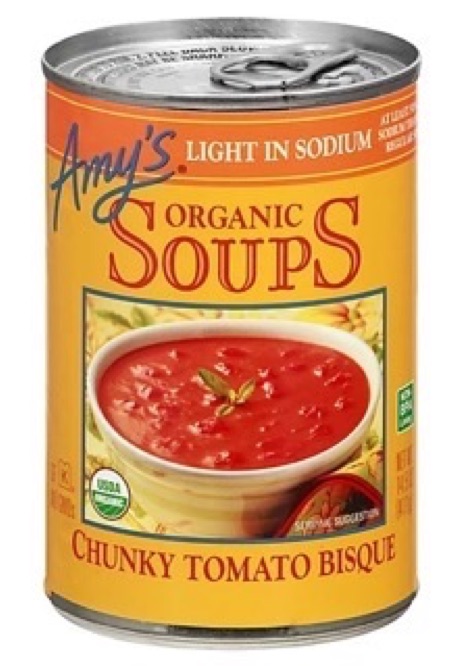
First, keep it simple and store soup varieties that your family now enjoys, perhaps canned versions of homemade favorites. Not sure what your family likes? Buy several brands of different varieties and set-up a family taste test. This will help with family “buy-in,” too.
Second, consider nutrition. Canned soups are low in calories—as low as 80 calories for a one-cup serving. While that might be helpful if you are trying to limit calories, in a crisis you will likely need more calories, not fewer. Soups that contain beans such as Campbell’s Bean with Bacon and Progresso Tuscan White Bean soup are more substantial and have good nutritional value, being high in fiber and protein. Creamy soups, as well as canned chili and stews are also higher-calorie options.
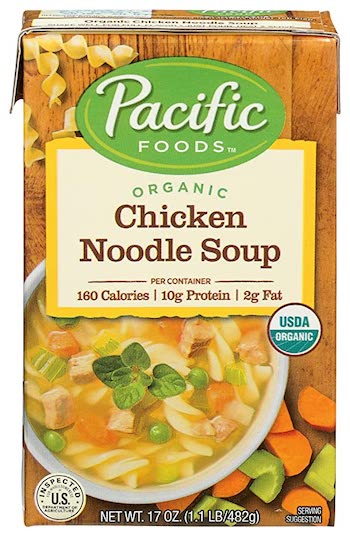
Soups contain additives and are typically high in sodium, often with 30% or more of the daily value in one cup—that’s as much salt as in 75 Lay’s potato chips! So, read nutrition labels. Some soup brands have fewer food additives—they are usually advertised as “healthy.” Check out the Pacific Foods Organic Chicken Noodle Soup and Organic Roasted Red Pepper & Tomato Soup in shelf-stable cartons.
Expect to pay about a dollar a serving for canned soup.
ADVANTAGES TO PURCHASING CANNED SOUP
The main advantage to stocking up on canned soup is that it is ready-to-eat with very little preparation. In an emergency this can be important. If necessary canned soup can be eaten right out of the can without heating.
- Little preparation time or effort required
- Offered in a wide variety
- Small and compact containers are easy to transport or share
DISADVANTAGES TO PURCHASING CANNED SOUP
- Cost one to two dollars per serving,
- Many varieties have a sameness in taste
- Often high in sodium and other food additives
- Low amounts of meat
How Many Cans of Soup Should You Store?
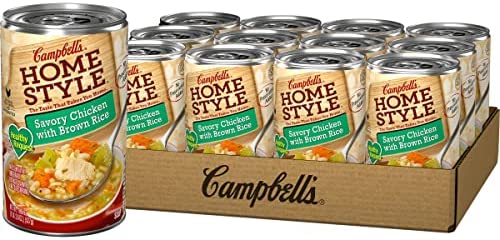
A typical can of soup contains about two one-cup servings. For four servings a week, you would need two cans per person. A family of four would need a minimum of two cans for a meal. They would need eight cans of soup for four servings in a week.
HOW MANY CANS OF SOUP FOR A FAMILY OF FOUR FOR ONE MONTH?
- 2 servings a week—16 cans
- 4 servings a week—32 cans
What Is the Shelf Life for Canned Soups?
Canned foods in general are shelf-stable and have a storage life of three to five years. Ideally, use the foods you store and replace them. As foods get close to their expiration date, consider donating them to your food bank and replacing with more recently canned foods.
Option 2-Store Dehydrated Soup Mix
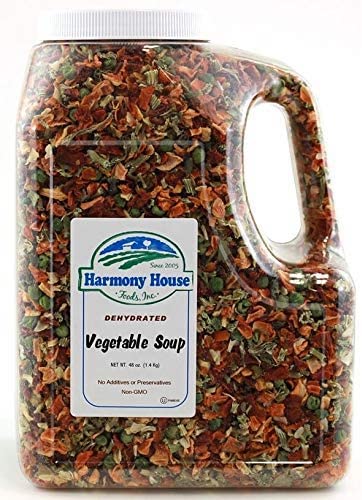
Dehydrated soup mixes are made with dehydrated or freeze-dried ingredients including dehydrated milk, dehydrated potatoes, freeze-dried or dehydrated vegetables, freeze-died meats (sometimes), and seasonings.
The highest quality dehydrated soups will have recognizable ingredients with few additives. Several food companies offer a nice assortment of dehydrated soup mixes. For example, Harmony House has a line of more than a dozen dehydrated “gourmet” soup mixes with wholesome ingredients and no additives.
Unfortunately, some dehydrated soup mixes are made from highly processed food ingredients with a long list of food additives, including high quantities of sodium. Check the nutritional labels.
Expect to pay between fifty cents and one dollar for a one-cup serving of dehydrated soup.
ADVANTAGES TO PURCHASING DEHYDRATED SOUP MIXES
- Easy to prepare—just add water and heat
- Improved selection of varieties
- Easy to adjust the amount you make
- Low volume uses small amount of storage space
- Long storage life
DISADVANTAGES OF PURCHASING DEHYDRATED SOUP MIXES
- Often contain a long list of food additives
- Dehydrated foods do not taste or have the texture of fresh foods
- Usually high in sodium
- Taste is often bland
Make Your Own Dehydrated Soup Mixes
An economical alternative to purchasing dehydrated soup mixes is to make your own. You can guarantee the quality, limit food additives, and adapt recipes to satisfy your family’s preferences.
They following recipes are a good starting point and may take some experimenting to get the proportions just right. Test a small amount of a recipe first to see if you like it.
HOMEMADE DEHYDRATED POTATO SOUP MIX
The basic mix is made from about equal parts of dehydrated potatoes and dry milk powder. You can add a little cornstarch if you prefer a thicker soup. For flavor, add chicken bouillon and any combination of seasonings listed.

INGREDIENTS
- 1 ¾ cup dehydrated potatoes
- 1 ½ cup dry milk powder
- 1-2 tablespoon chicken bouillon granules
- 1 tablespoon dried chives or minced dry onion
- Seasonings of your choice such as garlic powder, onion powder, celery salt, dried thyme, and parsley
- Add a bit of turmeric or paprika for color
- Salt and pepper to taste
Combine the dry ingredients and seal in Mason jars or resealable or vacuum-seal bags and label. Increase shelf life by adding an oxygen absorber. Dry soup mix will store for a year and a half to two years if stored in a cool, dry location. To make soup, combine ½ cup of soup mix with 1 cup of boiling water.
HOMEMADE DEHYDRATED TOMATO SOUP MIX
The basic mix is made from about equal parts of dehydrated tomatoes and dry milk powder plus dry bouillon and seasonings.
INGREDIENTS
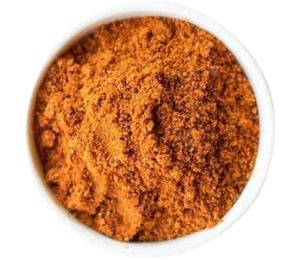
- 1 cup dehydrated tomatoes powder*
- 2/3 cup of dry milk powder
- 1 to 2 tablespoons of chicken bouillon granules
- Seasonings of your choice such as dried basil, dehydrated onions, or garlic powder
Combine and store in Mason jars or resealable or vacuum-packed bags. To make soup, combine ½ cup of soup mix with 1 cup of boiling water.
*You can purchase dehydrated tomato powder (about fifty cents a tablespoon), or economically make your own by dehydrating tomatoes until they are fully dry and brittle, then use a food processor to make a powder.
HOMEMADE DEHYDRATED VEGETABLE SOUP MIX
Another alternative to commercially packaged soup mixes is to package your own dehydrated vegetables. Combine and store in Mason jars or resealable or vacuum-packed bags.
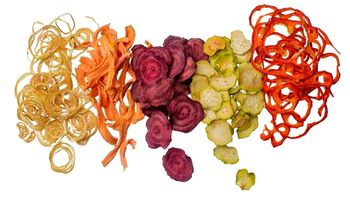
- 1 cup dehydrated sliced potatoes
- ¼ cup dehydrated onions
- A half cup each of assorted vegetables: carrots, cabbage, kale, summer squash, tomatoes, mushrooms, peppers
- 1 to 2 tablespoons of chicken or beef bouillon granules
- Seasonings of your choice such as dried parsley, thyme, garlic powder, basil, bay leaf, etc.
Combine and store in Mason jars or resealable or vacuum-packed bags. To make soup, combine 1 cup of soup mix with 1 cup of water and simmer until vegetables are soft.
STORE INGREDIENTS FOR MAKING HOMEMADE DEHYDRATED SOUP MIXES
If you prefer, rather than make the soup mixes, another alternative is to store the individual ingredients so you can make the soup as desired.
How Much Dehydrates Soup Mix Should You Store?
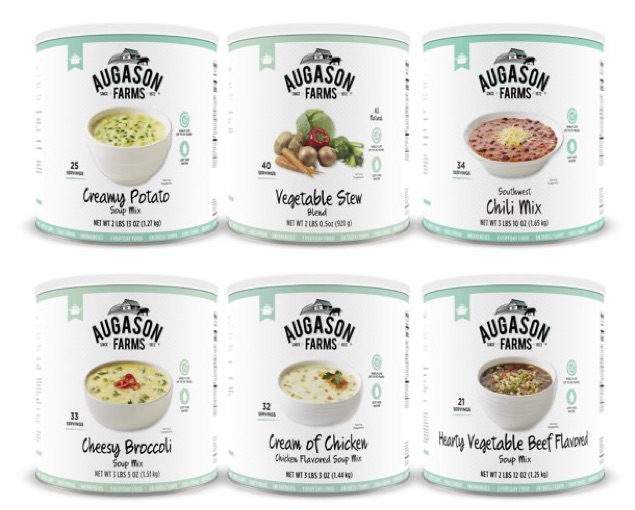
Commercially packaged soup mixes will state the serving size and the number of servings. Typically, #10 cans contain about 32 one-cup (reconstituted) servings. Check both the serving size and the number of servings to be sure. Homemade soup mix packaged in a Mason jar will yield 4 cups of mix and make about 8 cups of soup.
FOR A FAMILY OF FOUR FOR ONE MONTH
- 2 servings a week—32 servings (1 #10 can or 4 Mason jars of homemade soup mix)
- 4 servings a week—64 servings (2 #10 cans or 8 Mason jars of homemade soup mix)
What is the Shelf Life for Dehydrated Soups?
Dehydrated soups vacuum packaged in mylar bags with oxygen absorbers or sealed in cans with oxygen absorbers have a twenty-five year storage life. Store homemade dehydrated soup in sealed Mason jars for five years. Ideally, use your stored soup and replace it periodically.
Learn More
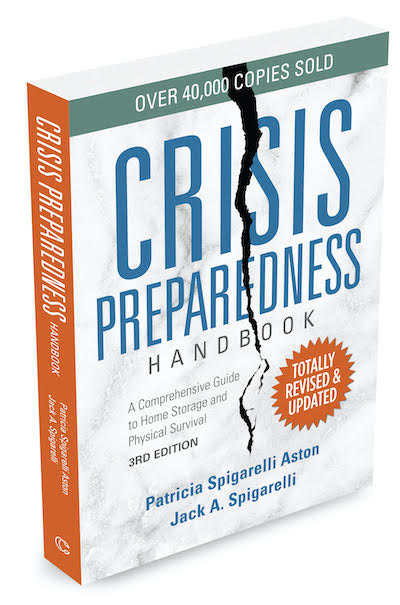
Find out more about preparing for a crisis or emergency in my book “Crisis Preparedness Handbook, Third Edition,”. Learn more about storing other foods and how to preserve food for storage. Also learn about water storage, sanitation, communication, transportation, etc. You can learn more about other areas of preparedness in my book Crisis Preparedness Handbook found on Amazon as a hard copy and in Kindle or on my website CrisisPreparedness.com.
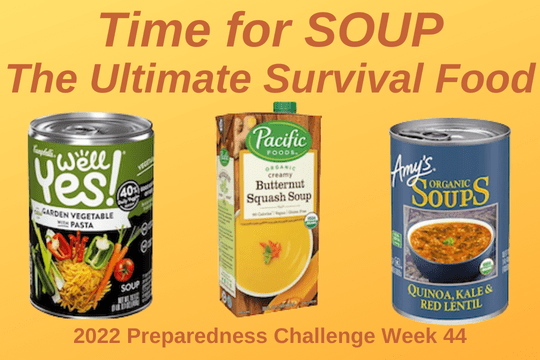


2 thoughts on “Make Sure You Have Soup—The Ultimate Survival Food!”
I just canned 6 quarts of loaded potato soup and still have prepare and can another 12 quarts. I have canned chicken and turkey soup also. I love to eat soup when it gets cold outside. love your preparing presentation.
Please? Your recipe? And Thanks!